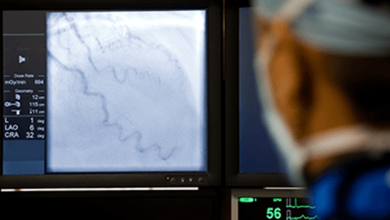Search results
Author(s):
Peter Mortier
,
Heleen MM van Beusekom
,
Matthieu De Beule
,
et al
Added:
3 years ago
Incomplete stent apposition (ISA) or stent malapposition is the lack of contact between stent struts and the underlying arterial wall. ISA has been associated with significantly higher levels of thrombus deposition1 and is typically assessed by intravascular imaging techniques such as optical coherence tomography (OCT) and intravascular ultrasound (IVUS).2–4 These imaging modalities are useful to…
View more
Author(s):
Tom Adriaenssens
,
Giovanni J Ughi
,
Jan Dhooge
,
et al
Added:
3 years ago
In the bare metal stent (BMS) era, several intravascular ultrasound(IVUS) studies have validated the strategy of reducing in-stent restenosis rates by a strict adherence to an optimal stent implantation technique, predominantly by avoiding stent underexpansion.1 In a first phase after the introduction of drug-eluting stents(2003), the spectacular reduction in restenosis rates, based on…
View more
Clinical Application of a Novel Self-expanding Coronary Stent in Acute Myocardial Infarction
Author(s):
Christian Spaulding
Added:
3 years ago
Article
Author(s):
Nieves Gonzalo
,
Javier Escaned
,
Fernando Alfonso
Added:
3 years ago
Background
Incomplete stent apposition (ISA) is defined as a separation of at least one stent strut from the vessel wall, not related with a side branch. The relevance of this phenomenon derives from intravascular ultrasound (IVUS) studies suggesting a potential relationship between ISA and stent thrombosis. The mechanism by which ISA can contribute to stent thrombosis remains unknown, but it has…
View more
Author(s):
Robert-Jan van Geuns
,
Katherin Awad
,
Alexander IJsselmuiden
,
et al
Added:
3 years ago
Significant advances have been made with new generation stents to further improve the results of percutaneous coronary intervention (PCI) and outcomes for patients. Drug-eluting stents introduced in the early 2000s, thinner strut stent platforms, and bioabsorbable polymers and stents are among these developments.1 Despite these advances, there remain some areas where optimal stenting continues to…
View more
Author(s):
Xiao-Fei Gao
,
Xiang-Quan Kong
,
Guang-Feng Zuo
,
et al
Added:
3 years ago
Coronary angiography is widely used to diagnose coronary artery disease and to guide percutaneous coronary intervention (PCI). However, 2D projection angiography cannot completely reflect the 3D coronary lumen, with several inherent limitations in evaluating plaque composition, vessel diameter, diffuse reference vessel disease, lesion severity, as well as the result of stent deployment. In the…
View more
Author(s):
Nicolas Foin
,
Eduardo Alegria-Barrero
,
Ryo Torii
,
et al
Added:
3 years ago
Drug-eluting stents (DESs) have contributed to a significant lowering of the incidence of restenosis and target vessel revascularisation (TVR) in bifurcations.1–4 A randomised study of bifurcation lesions using sirolimus-eluting stents revealed restenosis rates of only 4 % in the main branch (MB) and a TVR rate as low as 8.2 % at six-month follow-up,2 a marked improvement over that in historical…
View more
Author(s):
Gaku Nakazawa
,
Masataka Nakano
,
Marc Vorpahl
,
et al
Added:
3 years ago
The limited information regarding the long-term safety of drug-eluting stents (DES) for the treatment of ST-segment-elevation myocardial infarction (STEMI) has raised concern regarding its clinical safety, in particular with respect to the associated morbidity and mortality attributed to late stent thrombosis (LST). Observational studies in daily practice have shown that the risk of LST continues…
View more
Author(s):
Andrew SP Sharp
Added:
3 years ago
Introduction
Intravascular ultrasound (IVUS) can resolve abnormalities within the coronary artery to a degree that is not possible with angiography alone. With an axial resolution of 70-200 μm and lateral resolution of 200-400 μm, IVUS can provide information on arterial wall and luminal composition that can change clinical management decisions.
This document describes scenarios of clinical…
View more
Author(s):
Kalpa De Silva
Added:
1 year ago









